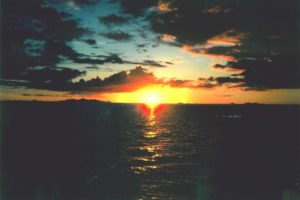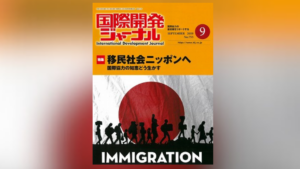Urgent Need to Actualise the Vision India Pacific Strategy and African Development
IDJ ENGLISH
『International Development Journal』 2019 January edition
US Bankrolling Intentions
In 2019, it is predicted that confrontation between the US and China in the Indo-Pacific will intensify further. The Asia-Pacific Economic Cooperation (APEC) Summit, held in Papua New Guinea on November 17-18, 2018, made that clear. More moderate US Vice-President Pence criticized China’s “Belt and Road Initiative” policy, as well as their aggressive infrastructure export business that fails to consider the financial capacity of the recipient countries.
However, despite the difference in value with regards to China, Japan cannot dismiss this as another person’s affairs. As a result of the confrontation between the US and China, the APEC Summit concluded without their being able to announce a Leaders’ Joint Declaration. However, for the first time in a while, one could see the brave figure of the United States as a world leader. The US Administration announced its intention of investing a total of $1.4 trillion in the India-Pacific strategy and another $60 billion in infrastructure. This may have a major impact, not only on China, but also on Japan. Japan’s businessmen, who paid close attention to infrastructure construction based on China’s Belt and Road Initiative policy, must have been surprised to see such bankrolling behavior by the US.
Pacific Perspective and Thinking
Yohei Sasagawa, chairman of the Japan Foundation, which supports the Pacific island countries, insists that Japan should pay more attention to the “One Road” out of China’s “Belt and Road Initiative”. “One Road” means the Asia Pacific. And the Pacific island countries have reached a time when they cannot be said to be merely a gathering of small island countries. A region linking islands in the vast Pacific Ocean has new value that is comparable to that of a large continent. If one of them is ruled by a different sense of values, the traditional order of the Pacific will change. In addition to Japan, Australia and New Zealand, which are members of the Pacific Ocean, this will undergo a major impact in terms of the peace and stability of ASEAN.
For example, Japan should be more serious about the development and independence of Palau, a strategic location on “the Second Island Chain” toward China. Although the current Palau President is pro-Japanese and pro-American, it is said that the next generation will inevitably yield to China’s huge money power. There is little room for optimism.
However, the Japanese government and the business community look at the Pacific island countries with only economic and market values, and do not consider the political and economic potential as a vast ocean space connecting many island countries by lines. In the provision of official development assistance (ODA), it is easy to determine the amount of aid simply by the population ratio without determining the potential value.
Recently, one point in the huge ocean area of the Pacific Ocean was broken. Vanuatu and Papua Guinea, most closely located to Australia, allowed China to develop ports with potentiality for military use. On the other hand, these island countries are now saddled with more debt.
However, from standpoint of China, since the establishment of a socialist regime, China has been surrounded by a so-called “Bamboo Curtain” of the western side and was blocked from coming down to the southern Asia-Pacific and Indian Ocean during the Cold War era of the 1950’s – 1970’s.However, China promoted a “reform and open policy” from the late 1970s, and, at the same time, it has expanded its power overseas. As the nation’s power increases, it has rapidly developed its military presence in the South China Sea and East China Sea. This is an action that can be called a kind of past reaction.
Apply ODA to the Indo-Pacific Strategy
On the other hand, Japan responded sharply to the movements of China and Prime Minister Abe, in 2007, addressed a speech named “Confluence of the Two Seas—the Indian Ocean and the Pacific,” at the Indian Parliament. It was developed to a “Free and Open Indo-Pacific (FOIP)”strategy. In particular, watching China’s military expansion in the South China Sea and East China Sea, he has emphasized the values such as freedom of navigation and the rule of law. He also calls for economic prosperity by strengthening connectivity through infrastructure development.
Such ideas do not necessarily counter China’s regional expansion into the Pacific Ocean and Indian Ocean. For Japan, the Indian Ocean is not only a sea-lane for oil transport from the Middle East, but also for trade with Europe and East Africa. It plays an important role as a sea route in terms of economic development and economic advancement in coastal countries.
Under these conditions, Japan has started to develop the Malacca Strait channel and has supported the development of ports that can be stationed for maritime routes from the Pacific Ocean, the Indian Ocean, and the east coast of Africa. However, such ODA achievements are not been well known widely. It is very disappointing.
On the Pacific side, ODA supports Port Vila port repair in Vanuatu, Apia port repair in Samoa, Patinban port development in the suburbs of Jakarta in recent cases in Indonesia, Sihanoukville port development in Cambodia, Laem Chabang port and Sattahip port in eastern Thailand. It also supports Thilawa port on the Indian Ocean side of Myanmar, improvement of the Colombo port and Trincomali port in Sri Lanka, Mombasa port development in Kenya, Nacala port development of Mozambique, expansion of Toamasina Port in Madagascar, and ferries to Djibouti.
Japan has supported the development and maintenance of ports in the world as a maritime nation and a trading nation. The results compare favorably with China’s BRI. Unfortunately, however, the extent to which the ODA results are linked with the national vision is unclear. Continuity is power. In this case, it will be necessary to re-examine each port development and maintenance by ODA from a strategic perspective.
Finally, I would like to raise an issue. How should it be linked to African development with the Pacific-Indian Ocean? I want the government to embody that strategy. The 7th Tokyo International Conference of the African Development (TICAD 7) in Yokohama is also coming soon. From now on, it is necessary to encourage countries facing the Pacific Ocean, such as Canada, USA, Australia, New Zealand, to participate in the development planning of TICAD. It is precisely the Pacific-Indian-Linkage Program. I would like TICAD 7 in Yokohama to take a leap from a different angle.
By Mitsuya Araki, Editor-in-chief of IDJ
***** 以下、日本語原文 *****
羅針盤 急がれるビジョンの具現化インド太平洋戦略とアフリカ開発
米国の大判振る舞いの意図
2019年は、インド太平洋を巡る米中の対立がさらに激化することが予測される。そのことを明示したのが、昨年11月17~18日 にパプアニューギニアで開催され た、アジア太平洋経済協力 (APEC)首脳会議であった。あの温厚なペンス米副大統領が、中国の「一帯一路」政策をはじめ、相手国の財政能力を考慮しない強引なインフラ輸出商法を厳しく批判した。
もっとも、中国とは価値 観の違いこそあれ、インフラ輸出で全力疾走している日本にとっては、決して他人事とは言えない。米中の対立は、慣例になっている首脳宣言をもまとめることができずに終わった。だが、久しぶりに世界のリーダー国家としての米 国の勇姿を見ることができた。米国は「自由で開かれたインド太平洋戦略」として、インド太平洋への総額投資額1兆4,000億ドル(約57兆9,500億円)、そしてインフラ支援として600憶ドル(約6兆 8,000億円)という驚くべき巨額の資金投入計画を表明した。これ は中国のみならず日本にも大きなインパクトを与えたのではないか。中国の一帯一路政策に基づくインフラ建設に色気を見せていた日本の財界人たちも、米国の大国らしい大盤振舞いには肝をつぶされる思いだったに違いない。
太平洋の見方、考え方
太平洋島嶼国を応援している日本財団の笹川陽平会長は、日本にとって中国の言う「一帯一路」のうち、「一路」が重視されるべきだと主張する。「一路」とはアジア太平洋を意味している。そして太平洋島嶼国は小さな島国の集まりであると言えない時代になっている。 広大な太平洋に点在する島々を線で結び合わせた海域は、大きな大陸に匹敵する新しい価値観を有している。もし、その中の一島でもこれまでと異なる価値観で支配されると、太平洋の伝統的な秩序が乱れることになる。太平洋の一員でもある日本、オーストラリア、 ニュージーランドのみならず、 ASEANの平和と安定にも大きな影響を与えることになる。 例えば、日本は中国に対して第2列島線上にある戦略的要衝の地・ パラオの自立発展にもっと親身になって支援すべきだ。現大統領は親日・親米だが、次の世代になると、間違いなく中国の巨額のマネー作戦に屈する恐れがあると言われる。決して楽観は許されない。
しかし、日本政府も財界人も、太平洋島嶼国をただ経済的・市場的な価値観だけで捉えて、多くの島嶼国を線で結んだ広大な海域空間としての政治的・経済的な潜在的価値を見出さない。政府開発援助(ODA)の供与も単純に人口比率で援助額を決めがちである。最近、太平洋の巨大な海域の一点が崩された。オーストラリアの面前のバヌアツやパプアニューギニアは、中国の軍事的色彩の強い港湾開発を許し、自らは巨額の借金に苦しむ破目になった。
ただ、中国側に立ってみれば、中国は社会主義政権を樹立して以来、50年代、60年代、70年代の冷戦時代に西側(欧米日)によって中国のアジア太平洋への南下を阻止する、いわば“竹のカーテン”で包囲され、太平洋、インド洋への出口がふさがれていた。
だが、中国は1970年代後半からの「改革・開放」政策の下で開かれた国になると同時に、海外への進出が可能になった。国力が増大すると、一気に南シナ海、東シナ海への軍事拠点化を推し進めることになった。これは、一種の過去の反動とも言える行動である。中国にとって、外洋展開が可能になるにつれ、一帯一路の一帯化(外洋進出)は歯止めがきかなくなる。
ODAをインド太平洋戦略に生かせ
一方、日本では中国の動きに鋭く反応し、安倍首相は第一次政権時代の2007年に、インド国会で「インド洋と太平洋の2つの海の交わり」と演説した。それ以来、「自由で開かれたインド太平洋戦略」と呼ばれるようになった。特に、中国が南シナ海や東シナ海での軍事拠点化を強引に進めることに対し、航行の自由、法の支配などの価値観を強調してきた。そして、インフラ整備などを通じた連結性の強化による経済的繁栄も求めている。
この考え方は、中国の太平洋、インド洋への一帯的進出に対抗したとは言わない。だが、日本にとってインド洋は中東からの石油輸送のシーレーンであると同時に、ヨーロッパとの交易、アフリカ東海岸諸国での経済開発、経済進出という面での海上ルートとして重要な役割を担っている。
そういう条件下で、日本はマラッカ海峡の航路整備から始まり、太平洋、インド洋、アフリカ東海岸にいたる海上ルートの拠点とも言える港湾開発を援助してきた。しかし、こうしたODA実績は広く世間に伝わっていない。非常に残念なことである。
太平洋側では、バヌアツのポートビラ港改修、サモアのアピア港改修、インドネシアの最近の例ではジャカルタ郊外のパティンバン港開発、カンボジアのシアヌークビル港整備、東部タイのレムチャバン港やサッタヒープ港、インド洋側ではミャンマーのティラワ港、スリランカのコロンボ港やトリンコマリ港整備、ケニアのモンバサ港開発、モザンビークのナカラ港開発、マダガスカルのトアマシナ港拡張、ジブチへのフェリー供与などをODAで支援している。
日本は海洋国家、貿易立国として世界の港湾開発・整備を援助してきた。その実績は、中国の一帯一路にひけをとるものではない。ただ、残念なことであるが、ODA実績がどこまで国家ビジョンと連動していたかは判然としない。継続は力である。この際、戦略的な視点で、ODAによる各港湾開発とそのメンテナンスをもう一度再検討する必要があろう。
最後に問題提起したいことがある。それは太平洋―インド洋を連結させながら、アフリカ開発にどう結びつけるべきかである。政府にその戦略を具体化してもらいたい。横浜での第7回アフリカ開発会議(TICAD7)も間近に迫っている。これからは、カナダ、アメリカ、オーストラリア、ニュージーランドなど太平洋に面する国々も、インド洋経由のアフリカ開発計画立案に参加するよう働きかける必要があろう。それはまさに、太平洋―インド洋リンケージ・プログラムである。横浜でのTICAD7はこれまでと異なるアングルから躍進させてもらいたい。
『国際開発ジャーナル』主幹 荒木 光弥




